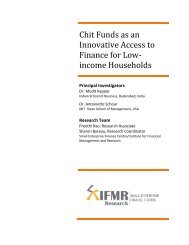Government of India Volume I: Analysis and Recommendations
Government of India Volume I: Analysis and Recommendations
Government of India Volume I: Analysis and Recommendations
Create successful ePaper yourself
Turn your PDF publications into a flip-book with our unique Google optimized e-Paper software.
RESOLUTION<br />
Table <strong>of</strong> <strong>Recommendations</strong> 7.1 Organisation structure <strong>of</strong> the resolution corporation<br />
The draft Code on resolution establishes a resolution corporation as a statutory body to carry out the resolution <strong>of</strong><br />
covered service providers. Covered service provider includes:<br />
1. each financial service provider that makes “covered obligations” as discussed in Table 7.2; <strong>and</strong><br />
2. each financial service provider designated by the Council as a SIFI.<br />
The resolution corporation must have representation from across the financial regulatory architecture, including<br />
the central bank, financial regulators, <strong>and</strong> the Central <strong>Government</strong>, <strong>and</strong> must be headed by a chief executive. The<br />
resolution corporation must have representation <strong>of</strong> independent experts. The resolution corporation must also have<br />
an administrative law member on its board. The establishment <strong>of</strong> the resolution corporation will be carried out in<br />
alignment with the principles <strong>of</strong> legal process identified by the Commission.<br />
Accordingly, the board <strong>of</strong> the resolution corporation will consist <strong>of</strong> executive, non-executive <strong>and</strong> nominee members,<br />
to be appointed by the Central <strong>Government</strong>:<br />
1. the total number <strong>of</strong> members must not be more than nine (9);<br />
2. the total number <strong>of</strong> non-executive members must be greater than the total number <strong>of</strong> executive members;<br />
<strong>and</strong><br />
3. three (3) members will be nominee members.<br />
The executive members will include –<br />
1. the Chairperson <strong>of</strong> the corporation; <strong>and</strong><br />
2. an administrative law member.<br />
The nominee members will consist <strong>of</strong> –<br />
1. one nominee <strong>of</strong> the Reserve Bank;<br />
2. one nominee <strong>of</strong> the Unified Financial Authority; <strong>and</strong><br />
3. one nominee <strong>of</strong> the Central <strong>Government</strong>.<br />
The board will appoint a senior <strong>of</strong>ficer <strong>of</strong> the corporation to act as secretary to the board.<br />
Table <strong>of</strong> <strong>Recommendations</strong> 7.2 Objectives<br />
Resolution <strong>of</strong> covered service providers that are approaching failure should be carried out with the objectives <strong>of</strong>:<br />
1. Protecting the stability <strong>and</strong> resilience <strong>of</strong> the financial system;<br />
2. Enhancing financial market efficiency through efficient pricing <strong>and</strong> allocation <strong>of</strong> risk;<br />
3. Protecting consumers <strong>of</strong> covered obligations up to a reasonable limit; <strong>and</strong><br />
4. Protecting public funds.<br />
emerging global arrangements on cross-border resolution. Developments in this regard<br />
may well require amendments to the law in the future, such as to require the resolution<br />
corporation to co-ordinate with its counterparts in other jurisdictions. In this regard, the<br />
Commission recommends that, in five years from now, a committee be set up to review<br />
the emerging consensus in this field <strong>and</strong> suggest amendments in the legal framework on<br />
resolution accordingly.<br />
7.3. Objectives <strong>of</strong> the resolution corporation<br />
Designing an effective resolution mechanism requires clarity <strong>of</strong> objectives in performing<br />
resolution. Table 7.2 outlines the objectives <strong>of</strong> the resolution corporation that must guide<br />
its functioning.<br />
The increasing size <strong>of</strong> deposit-taking institutions <strong>and</strong> the emergence <strong>of</strong> financial conglomerates<br />
have increased the risk to financial stability from firm failure. To address this<br />
concern, regulatory regimes have tried to redefine the scope <strong>of</strong> resolution. Internationally,<br />
regulators are now moving to broaden the m<strong>and</strong>ate <strong>of</strong> resolution authorities to include<br />
any SIFI including banks, holding companies, non-bank financial corporations, <strong>and</strong><br />
financial market infrastructure such as payment, settlement <strong>and</strong> clearing systems. The<br />
Code drafted by the Commission envisages a resolution corporation <strong>of</strong> similar scope.<br />
FINANCIAL SECTOR LEGISLATIVE REFORMS COMMISSION 71



